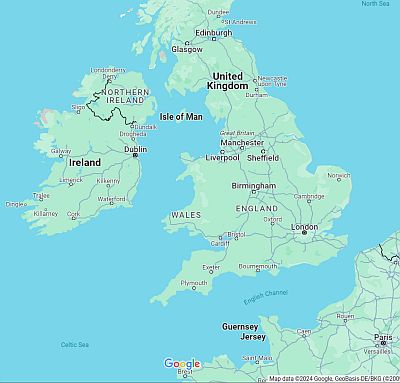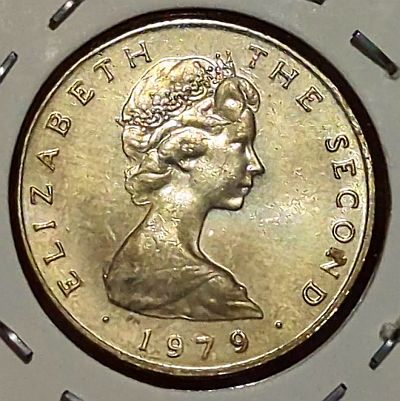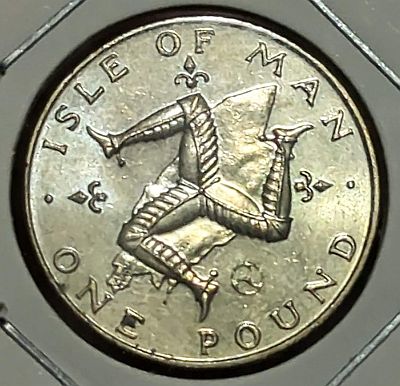The first circulating base metal pound coin in the British Isles
Isle of Man
There are three island territories within the British Isles that are known as Crown Dependencies; these are the Bailiwicks of Jersey and Guernsey which make up Channel Islands, and the Isle of Man. The Crown Dependencies are not part of the United Kingdom, but are self-governing possessions of the British Crown. We’ve looked at the Channel Islands previously covering the 1/52 Shilling from Jersey. Today let’s jump across the mainland to the Isle of Man. Situated in the Irish sea – the body of water which separates Ireland from Great Britain. Remembering England, Scotland and Wales make up Great Britain; the United Kingdom includes Great Britain and Northern Ireland, and the British Isles includes the UK, the Channel Islands and the Isle of Man.

(Map from Google showing Ireland left, Great Britain right, Isle of man between them, France and the Channel Islands below)
Similar to the Channel Islands, the Isle of Man has only been an island for around 8,000 years, with the first humans arriving sometime before then.
Early in its history the first Celtic tribes arrived and began to inhabit the island; it is likely that these immigrants arrived from Ireland, as the current Manx Gaelic language so closely resembles Irish Gaelic. The island’s name derives from Manannán, a Celtic sea god.
The island’s conversion to Christianity in the fifth century is generally attributed to St Maughold, an Irish missionary with a very colourful past.
By 850 A.D. the vikings had arrived and began to settle, and the Island’s parliament, Tynwald, was established by the Viking settlers, in 979.
Today, the island is particularly famous for the Isle of Man TT festival, a two month long racing carnival, particularly featuring motorcycles racing around the islands otherwise public roads.
Obverse

Back to the coin and the obverse is quite standard for a British Crown dependency coin. It features Queen Elizabeth II facing right, with the text “Elizabeth The Second” around the edge, and the year, 1979, below. This particular coin was issued between 1978 – 1982.
Virenium
One thing which got my attention in looking this coin up was the composition. It is made of Virenium, a material I wasn’t familiar with. The British Museum defines Virenium as a patented silver-coloured base metal alloy in the Nickel Silver family, often used for commemorative coins and medals. Composed largely of copper, with nickel, zinc and other constituents. Intended to have the look and stability of precious metal. Used in high denomination coinage since 1978. Trademark of Pobjoy Mint Ltd.
As the first base metal circulating coin worth “one pound” to be struck anywhere in the British Isles, it is not surprising it called for a “new” material to mint it in. The first pound coin was struck in 1592 under Elizabeth I.
Pobjoy mint
The Pobjoy mint was a private mint in Surrey, England. One of the most well-known private mints, it operated from 1965 – 2023. The Pobjoy mint had a good relationship with the Isle of Man. The Pobjoy’s first license to design and strike legal tender coins was for the Isle of Man’s 25-pence coin in 1972. That coin commemorated the 25th Wedding Anniversary of Queen Elizabeth II and Prince Philip. As of early 2024, Pobjoy have been responsible for 1,396 of the 1,867 Isle of Man coins listed on Numista.
Reverse

Back to the pound coin, the reverse features the territory name top and value bottom. In between is the Triskeles emblem, on a map of the Isle of Man, with a fleur-de-lis either side. On this 1979 coin, there is also a small triskelion in a circle, above the O in “POUND”. This does not feature on the other years. If anyone knows why, please do comment below and let me know!
On the lower-left part of the map are two letters. The letters are either AA, AB, AC, AD, BB or BC. (This example has AA). Again, I’m not clear on the purpose of the different letters. Possibly a control mark from the mint? (They may have done something slightly different with various coins and the mintmarks would then tell them which technique worked better?)
Triskele
Derived from the Greek word “Triskeles” meaning “three legs”, the Triskele, Triskelion or Triple Spiral is a complex ancient Celtic symbol. Dating back to the Neolithic era, it can be seen at the entrance of Newgrange, Ireland. It gained popularity in Celtic culture from 500 B.C.
While many people most immediately associate it with the Isle of Man, the a similar symbol, the Trinacria, is the symbol of Sicily, in Italy.
Being in use for so long, and by a wide range of people, the symbol has numerous meanings. One of the main meanings is of motion. All three arms are positioned to make it appear as if it is moving outwards from its center. Movement, or motion, is believed to signify energies, in particular within this Celtic Symbol the motion of action, cycles, progress, revolution and competition.
The connotations of the three arms are varied and debated. From past-present-future or life-death-rebirth to the Christian Trinity (God the Father, Son and Holy Spirit).
“The Manx triskelion” with three human legs in armour, also called the “Three Legs of Mann” as depicted on the coin, has been the symbol associated with the Isle of Man since at least the 13th century. Used by kings of the island and retained when control passed to the English crown, the symbol appears on everything from the flag, coat of arms, the Great Laxey Wheel, to the busses.


Leave a Reply